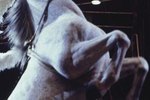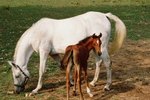
Many horsemen look in a horse's mouth to estimate the age of a horse. They look for the presence of milk teeth for young horses. In older horses they look at the shape of the incisors, and the presence of cups, stars and spots on the grinding surface of the teeth. For horses over ten years old there is a dental feature called Galvayne’s groove on the upper third incisor, which is a good indicator of age.
Galvayne’s Groove
Galvayne’s groove is a darkish groove that is present on the upper corner incisor teeth in horses between the ages of around 10 to 30 years. It is named after Sydney Galvayne, an Australian born Irishmen, who was renowned for his ability to tell the age of horses he had never seen before by looking at their dentition. It is a useful method to estimate age when a horse has no papers.
From Age 10 to 20
Galvayne’s groove first appears at the gum line in the center of the tooth when the horse is about 10 years of age. Each year it will extend a little further down the tooth. At 15 years the groove extends halfway down the tooth, and by 20 years the groove extends the full length of the tooth. You must estimate how far down the tooth the groove is to estimate the horse's age.
From Age 20 to 30
Once the groove reaches the full length of the tooth, around age 20, it begins to disappear. It begins to fade from the top at the gum line, and by age 25 Galvayne’s groove will have gone from the top half of the tooth and be present only on the bottom half. By around age 30 it has completely disappeared. You must estimate the percentage of groove that remains to estimate the horse's age.
Other Considerations
Galvayne’s groove can be used only to age horse between the ages of 10 and 30. Sometimes the groove will be a little different on the right and left sides of the mouth, so it is best to take an average of what the two grooves suggest the age should be. Dental wear can be different between breeds, and can be influenced by diet, environmental factors and management factors, like teeth filing. Galvayne’s groove will give a good guide to age, but is not completely accurate.
References
Resources
Photo Credits
-
Digital Vision./Digital Vision/Getty Images



